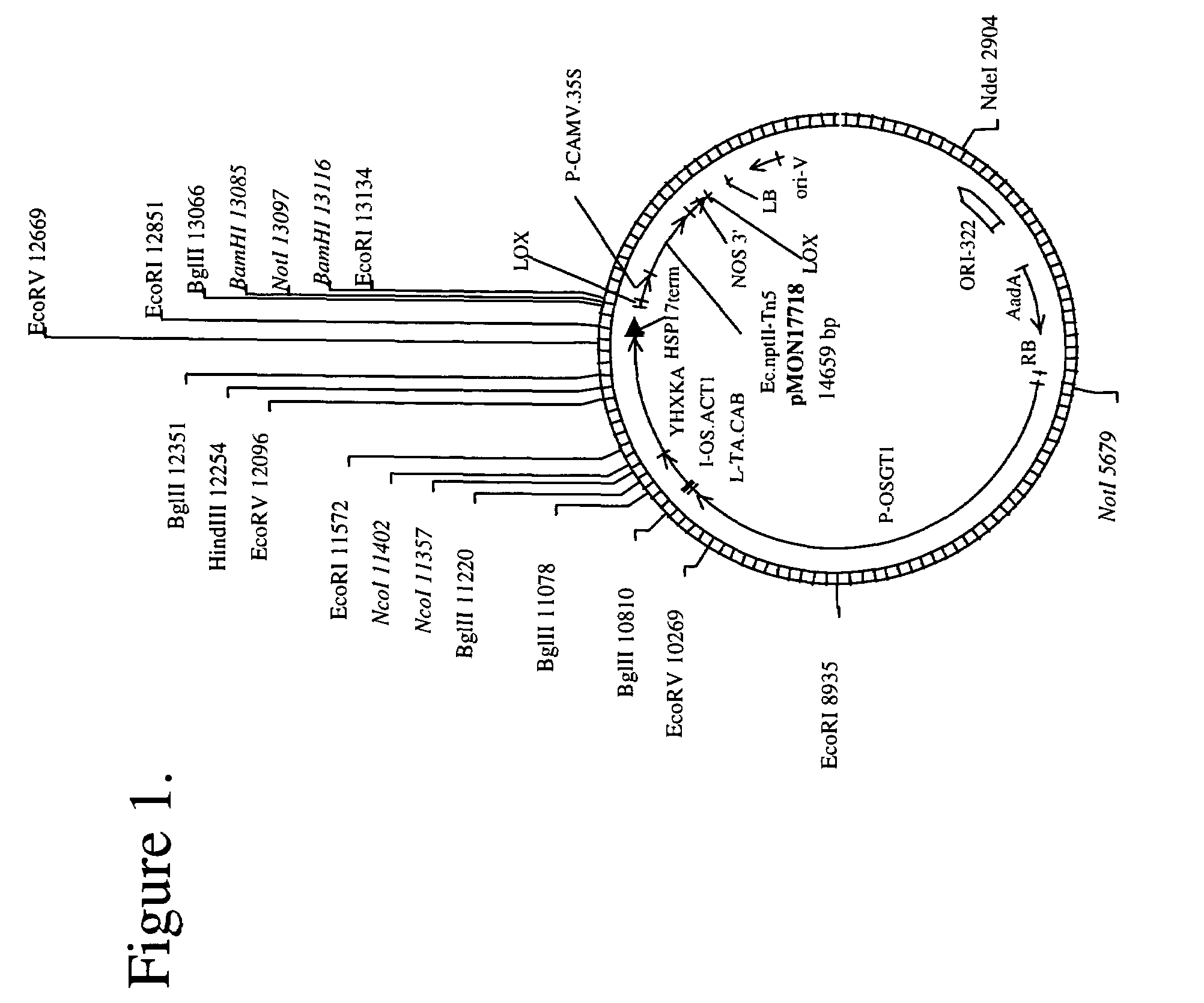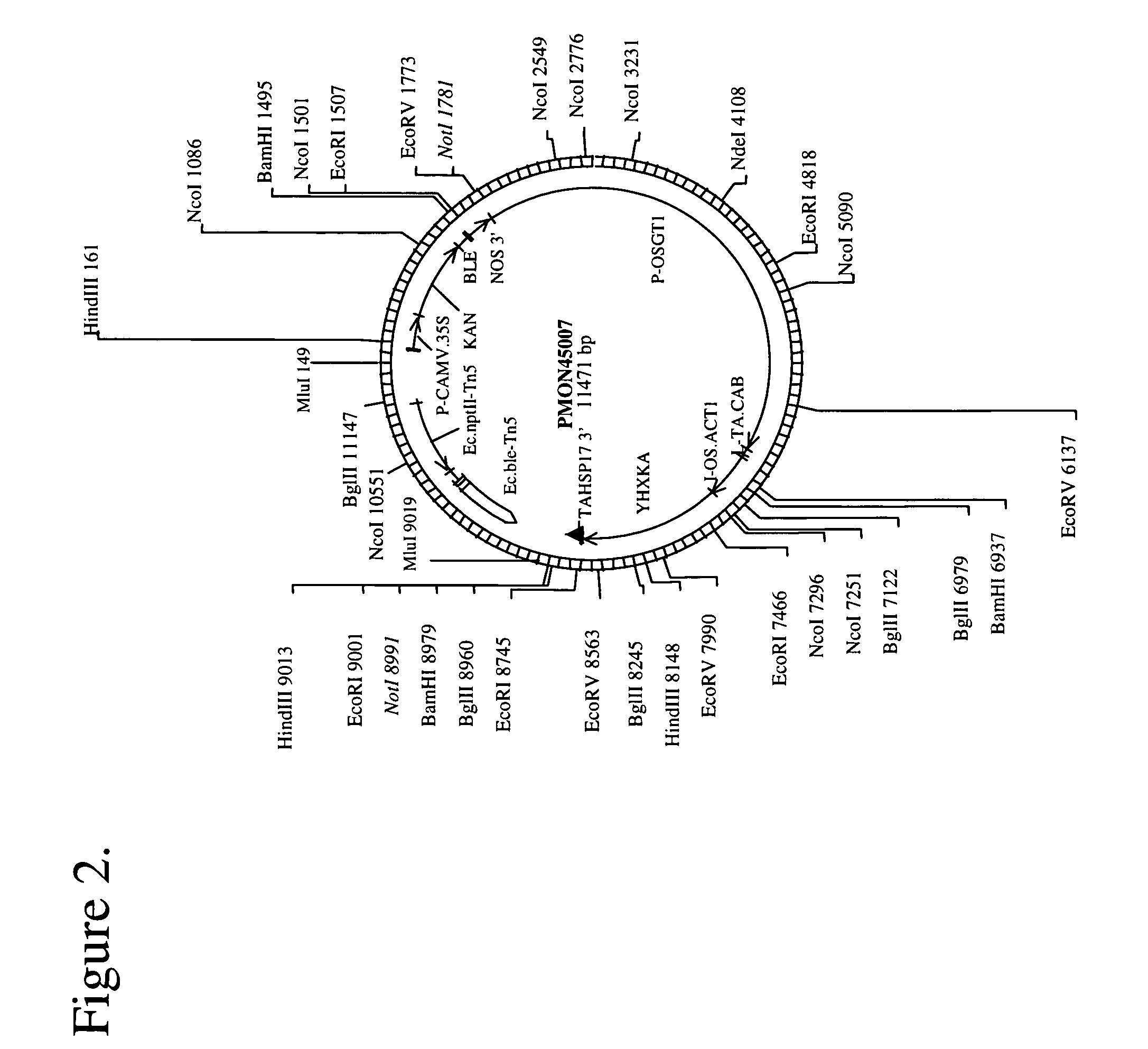Method of increasing yield in a plant and genes useful therefor
a technology of plant genes and coding sequences, applied in the field of plant molecular biology, can solve the problems of seed senescence, unfavorable hexokinase under a constitutive promoter, and negatively affecting starch production, so as to improve the expression of hexokinase coding sequences, increase starch content, and reduce sugar content
- Summary
- Abstract
- Description
- Claims
- Application Information
AI Technical Summary
Benefits of technology
Problems solved by technology
Method used
Image
Examples
example 1
PCR of Hexokinase From Yeast and Cloning to Create pMON45006
[0100]The complete coding sequence of yeast hexokinase (yHxkA) (SEQ ID NO:1) was PCR amplified from yeast genomic DNA based upon publicly available sequence data (Genbank gi:171736, using primers ATAGGATCCATGGTTCATTTAGGT [SEQ ID NO:2] and AAACTCGAGTTAAGCGCCAATGAT [SEQ ID NO:3]). The 5′ and 3′ ends of the nucleotide sequence were modified to include a BamHI and XhoI restriction sites, respectively. This PCR product was isolated and cloned into the commercially available pET30a+vector (Moffatt, B. A. and Studier, F. W. (1986) J. Mol. Biol. 189, 113-130; Rosenberg, A. H., Lade, B. N., Chui, D., Lin, S., Dunn, J. J., and Studier, F. W. (1987) Gene 56, 125-135; Studier, F. W., Rosenberg, A. H., Dunn, J. J., and Dubendorff, J. W. (1990) Meth. Enzymol. 185, 60-89) from Invitrogen (Carlsbad, Calif.), using restriction enzymes. The pET30a+ vector and related vectors are available from Novagen, an affiliate of Merck KgAa, Darmstadt, ...
example 2
Creation of Plasmid pMON17718 and 45007
[0101]pMON17718 (SEQ ID NO:33): This plasmid was used as the plant transformation vector for the creation of transgenic corn plants discussed in later examples. A portion of this sequence is shown in SEQ ID NO:34. The plasmid consists of a gene of interest expression cassette consisting of a glutelin-1 promoter (gt1), wild-type (wt) wheat cab (chlorophyll a / b binding protein) leader, rice actin 1 (ractin1) intron, yeast hexokinase A coding region (HXK) (SEQ ID NO:1) and an NOS 3′ terminator. The plasmid also contains the selectable marker (NPTII). The vector was constructed by combining the Not 1 fragment containing gt 1 promoter, wt cab leader, rice actin1 intron / HXK, and NOS 3′ terminator from pMON 45007 (SEQ ID NO: 32; FIG. 2) with the NotI fragment of pMON 36176 (FIG. 3) containing the selectable marker (NPTII). The plasmid also contains the right and left border required for agrobacterium transformation. This vetor was used to transform co...
example 3
Selection of Events in Corn. (pMON45007)
[0104]pMON45007 was transformed into corn plants using a particle gun mediated transformation.
[0105]The expression of yeast hexokinase A (HXK) in elite corn was confirmed by Western blot analysis using a rabbit antibody raised against HXK (Garvey, et al., Methods in Immunology, 3rd edition, W.A. Benjamin, Inc., Reading Mass., 1977, Part I). Homozygous material was identified from R2 seed by selfing plants identified as positive or negative at the R1 generation. Once homozygous material was obtained, experiments were initiated to determine the efficacy of HXK in the seed of a plant.
PUM
| Property | Measurement | Unit |
|---|---|---|
| Tm | aaaaa | aaaaa |
| temperature | aaaaa | aaaaa |
| temperature | aaaaa | aaaaa |
Abstract
Description
Claims
Application Information
 Login to View More
Login to View More - R&D
- Intellectual Property
- Life Sciences
- Materials
- Tech Scout
- Unparalleled Data Quality
- Higher Quality Content
- 60% Fewer Hallucinations
Browse by: Latest US Patents, China's latest patents, Technical Efficacy Thesaurus, Application Domain, Technology Topic, Popular Technical Reports.
© 2025 PatSnap. All rights reserved.Legal|Privacy policy|Modern Slavery Act Transparency Statement|Sitemap|About US| Contact US: help@patsnap.com



